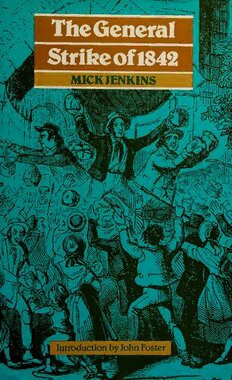
The General Strike of 1842 PDF
Preview The General Strike of 1842
The General Strike of 1842 MICK JENKINS Introduction by John Foster The General Strike of 1842 Mick Jenkins Introduction by John Foster The 1842 General Strike involved nearly half a million workers all over Britain and was probably the first strike anywhere that can truly be called general. Coming at the height of the Chartist campaign for basic democratic rights in Britain, it began as a movement of united resistance to the imposition of wage-cuts among workers in the coal, cotton and engineering industries. Almost immediately the strike took on a political character and became an all-out struggle for universal suffrage backed by the Executive of the National Charter Association, spreading from Lancashire, Staffordshire and the West Riding, through the coalfields of Scotland and South Wales, to the poverty-stricken woollen weavers of Somerset and Norfolk. Lasting in some areas up to six weeks and resulting in over 1,500 arrests and numerous clashes with troops, the General Strike of 1842 represented the biggest single exercise of working-class strength in nineteenth-century Britain. This book, extensively illustrated with contemporary prints, is the first full-length treatment of the 1842 Strike as a whole. The author examines its origins in South-east Lancashire, supplies pen-portraits of its outstanding leaders, and establishes for the first time the extent of their links with the Chartist movement. He uses the personal correspondence of the Home Secretary to reveal the subtlety of government tactics and shows how, in the aftermath of the strike, the government used persuasion as well as force to split apart the industrial and the political aspects of working-class struggle, and so helped lay the basis for the strength of the reformist tradition in British politics. In his Introduction John Foster writes: ‘In telling this story the book returns to the working people of Britain one of the finest episodes in their history, and at the same time compels historians to reassess a number of crucial aspects in the country’s political development.’ 8 maps 21 illustrations ISBN 85315 488 0 Digitized by the Internet Archive in 2019 with funding from Kahle/Austin Foundation https://archive.org/details/generalstrikeof10000jenk The General Strike of 1842 THE GENERAL STRIKE OF 1842 by Mick Jenkins Introduction by John Foster Distributed in the U.SJ\. by Humanities Press Atlantic Highlands, N. J. LAWRENCE AND WISHART London Lawrence and Wishart Ltd 39 Museum Street London WCt First published 1980 Copyright © Mick Jenkins 1980 This book is sold subject to the condition that it shall not, by way of trade or otherwise, be lent, re-sold, hired out, or otherwise circulated without the publisher’s prior consent in any form of binding or cover other than that in which it is published and without a similar condition including this condition being imposed on the subsequent purchaser Printed and bound in Great Britain at The Camelot Press Ltd, Southampton Contents List of Illustrations 8 List of Figures 10 I ntroduction by John Foster 13 Preface 21 CHAPTER 1 THE GENERAL STRIKE: A WEAPON IN THE STRUGGLE FOR DEMOCRACY 27 William Benbow and the idea of the General Strike - General strikes and the struggle for democracy before Chartism — Chartism and industrial action CHAPTER 2 ECONOMIC CRISIS 41 The experience of poverty — The first and biggest working class - Twenty-five years’ progress in the cotton industry — ‘Wages must go down ’ CHAPTER 3 THE TURN-OUT 60 The strike movement starts among the Staffordshire miners - Storm-centre of the strike: South-East Lancashire - Monday, 8 August: the strike spreads- Tuesday, 9 August and Wednesday, 10 August: Manchester turns out - The spread of the turn-out beyond Manchester -The pattern of events in the first days of the turn-out CHAPTER 4 RICHARD PILLING IO7 The conventional assessment — Class leader and Chartist — National mass leader -The making of a working-class militant - The class conscious worker CHAPTER 5 ALEXANDER HUTCHINSON 128 Champion of trade union unity - The Trades Journal — The 6 The General Strike of 1842 United Trades’ Association-Support for Chartism— Trade unions prepare for the General Strike - A testimonial from his fellow workers CHAPTER 6 THE TRADES CONFERENCES H2 The evolution of the Trades Conference and of the strike policy — Local trades conferences outside Manchester - The Great Delegate Conference CHAPTER 7 THE SECOND WEEK: THE STRIKE BECOMES A CLASS STRUGGLE 1 6 1 The Chartist Conference — London workers support the strike — The response of the employers - The shopkeepers and small trades¬ men -The ‘terrible tide of thought and energy’ CHAPTER 8 THE STATE PREPARES TO CRUSH THE STRIKE 191 The main enemy: solidarity - Preparing the instruments of sup¬ pression - Parts of the state machine breakdown — The state resorts to harassment and intimidation CHAPTER 9 ‘UNCONQUERABLE COURAGE’: THE STRIKE CON¬ TINUES INTO SEPTEMBER 205 The central leadership is removed — The battle for a living wage — Women take up the struggle CHAPTER 10 CLASS JUSTICE AND THE STATE 2ig Prosecution tactics - The operation of the law in Autumn 1842 — Class law accused - March 1843: ‘conciliation ... the order of the day’ CHAPTER 11 WORKING-CLASS CONSCIOUSNESS ASSERTS ITSELF 24.O ‘Political cobblers and hatters ’: the men who launched the strike - Strikers of a new type - ‘The assailants are united: in the defence the greatest dissension prevails ’ APPENDIX A: RESOLUTIONS AND ADDRESSES OF THE TRADES CONFERENCES 26l APPENDIX B: ADDRESSES OF THE NATIONAL CHARTIST CON¬ FERENCE 97n
